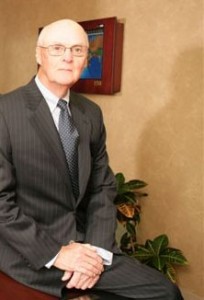Successes of Bryan Satterlee ’56 lead Harvard Business School to take notice
By Dan Edelen
 When people at IBM, then in its mainframe computer heyday, discovered that Bryan Satterlee ’56 wanted to leave the company after ten years, they thought he’d lost his mind.
When people at IBM, then in its mainframe computer heyday, discovered that Bryan Satterlee ’56 wanted to leave the company after ten years, they thought he’d lost his mind.
“For three months, IBM had a psychiatrist interview me to see if I was OK,” he says.
Tom Watson Jr., the iconic head of the company, wanted to understand why someone would forgo a future position as a corporate vice president to explore other opportunities. IBM couldn’t grasp that Satterlee had to “follow my bliss.”
For the business graduate, taking the ball and running with it gained momentum at Lafayette and never flagged. As a star on the football team, his favorite play was “anything that allowed me to have the ball.” The coaches saw that desire and moved him from quarterback to halfback, where in the 1953 Lehigh-Lafayette game he had an 87-yard run from scrimmage, a record that remained unbroken for more than 20 years.
With the NFL calling after graduation, Satterlee had three options: football, the Wharton business school, or IBM. On the cusp of releasing its first computer, IBM proved the winner. Satterlee enjoyed success in marketing and sales management, but after a decade, that “bliss” called.
Deemed perfectly sane, Satterlee left IBM at the top of his game. Seeing opportunities that his previous firm had ignored, he decided to start his own company. And who would serve as a reference when Satterlee asked for millions from investment bankers? Watson, who said, “He’s OK!”
Satterlee’s start-up pioneered the leasing of IBM 360 Series mainframes, a radical idea at the time. “Normally, I’m either ahead of the market or there at the right time,” he says. “You have to be pretty damned confident that you are right.”
That market sense proved canny when he founded his next company, maker of the first all-electronic business phone system. In light of Satterlee’s success, Harvard Business School wrote a case study on his ventures to discuss how a start-up company can compete against large competitors like AT&T and IBM.
With his knowledge of starting and funding businesses, Satterlee co-founded Northeast Ventures in 1989. His company made minority investments in 45 high-tech ventures, nearly all surviving the Internet bubble of the early 2000s. In 1997, Satterlee was elected to the board of EPIQ Systems Inc., a public company offering integrated technology solutions for the legal profession. He now serves as one of EPIQ’s independent directors and chairman of the audit committee.
Satterlee credits his grandfather, one of the builders of the New York City subway system, with instilling his entrepreneurial gifts. He also lauds his father, a lawyer who played first base for a season with the Boston Red Sox, with teaching him that it’s “books before ball.” To this day, he still pursues learning, going back to college to complete a course on Life in the Universe.
At 73, Satterlee says, “I’ve still got a lot to do.” He and his wife, Patricia, made a three-month journey around the world last year, visiting 20 countries. He enjoys golf and tennis and owns thoroughbred horses.
“Life is not over,” he says. “There’s so much to do every day. Follow your bliss and find the peak experiences.”
 When people at IBM, then in its mainframe computer heyday, discovered that Bryan Satterlee ’56 wanted to leave the company after ten years, they thought he’d lost his mind.
When people at IBM, then in its mainframe computer heyday, discovered that Bryan Satterlee ’56 wanted to leave the company after ten years, they thought he’d lost his mind.